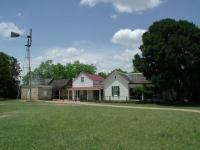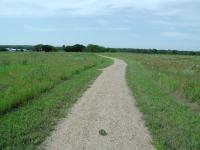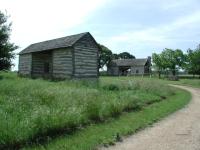
The trails on the eastern side of the park are shaded. There's even a nice creek crossing.
From Johnson City head west on Hwy 290 for 9.5 miles. Turn right onto Ranch Road 1 and continue west for 3.3 miles. Look for the state park entrance and parking lot on the left.
The Park: The Lyndon B. Johnson State Park and Historic Site is part of a
unique partnership with the LBJ National Historical Park that lies on the opposite side of the Pedernales River. Bus tours of the former President's home within the national park leave from the grounds of the state park. There is a fee for the bus tour, but no charge for admission to the state park for other uses.
Bus tours are not the only thing one can enjoy while
visiting. The park boasts of trails on the two distinct sides of the park. The older Paseo Del Arroyo loops through the eastern half of the park. It starts at the park HQ building marked with the waypoint "HQ" on the topo map.

The trail passes through the working Sauer-Beckmann farm which provides a glimpse into what life was like in the early 1900's.
Heading in a clockwise direction through the connected loops, the trail passes by a statue of the former President at the waypoint "LBJ Statue". He can be seen pointing as if given a stern lecture to a Congressman, but he also happens to be pointing in the general direction of his old home across the river.
The trail surface is largely crushed granite and is fairly flat. The trails on the eastern side
of the park are well shaded by the wide variety of trees. Interpretive signs along the
trail identify many of the species, which included Mesquite, Post Oak, Hackberry, Chinquapin Oak,
Sumac, Ashe Juniper, Mexican Silktassel, Black Willow, Mexican Buckeye, Live Oak and Red Bud
and probably a few that I missed.

The trail on the western side of the park is wide open, with little shade.
The Paseo Del Arroyo trail passes by several animal enclosures which are reported to contain
Longhorns, White-tailed Deer and Bison. I could clearly see the deer and I believe I caught a
glimpse of the rump of a Longhorn, but I saw no sign of Bison. Strangely, an
interpretive sign for the Bison was found behind a thicket of brush off the trail, as though it
had been forgotten.
-small.jpg)
The wide open fields yield a thick blanket of wildflowers.
Before turning back towards the park HQ building, the Paseo Del Arroyo trail passes right through the Saur-Beckmann Farm, a living farm that demonstrates what life
was like on a Texas farm in the early 1900's. Sheep, chickens and turkeys congregate in the back while costumed volunteers go about their chores around the farm. A lady was preparing milk to make cheese as I passed through. Complete meals are prepared here the old fashioned way using meat, milk and produce grown and processed on site.
-small.jpg)
The bountiful wildflowers drew a large number of butterflies to the area.
The newest trail at the park is the ADA-compliant Nature Trail that ventures into the western side of the park. The trail surface is all crushed granite and is flat and easy as can be. Unlike the Passeo Del Arroyo trail there is no tree cover here at all. What's to like about this trail? Lots!
The trail here passes through some of the densest fields of wildflowers I can recall seeing anywhere. In the middle of May, the timing was perhaps a little late for optimal blooming (the Bluebonnets were almost completely gone) but the variety and volume of wildflowers was stunning. A trip back to the park at the peak of wildflower season would definitely be in order.

The main Danz cabin dates from 1860 and was built by German immigrants.
A plethora of wildflowers has an added benefit in the form of butterflies. Eager to tap into the harvest of nectar a large number of butterflies flitted about from flower to flower. At no time did there not appear a butterfly in sight along the trail.
The waypoint "Danz Cabins" marks the location of homestead for the German immigrant Danz family. The larger cabin to the south was originally constructed here in 1860.
Taking time to read the interpretive signs and try to identify flowers, trees and butterflies it took almost three hours for me to cover a bit over 4 miles on trails that I traveled over more than once. Although not available online, the park does have trail maps on hand at the park. LBJ State Park provided a pleasant outing, and with no admission fee for hiking, it was a bargain
to boot!